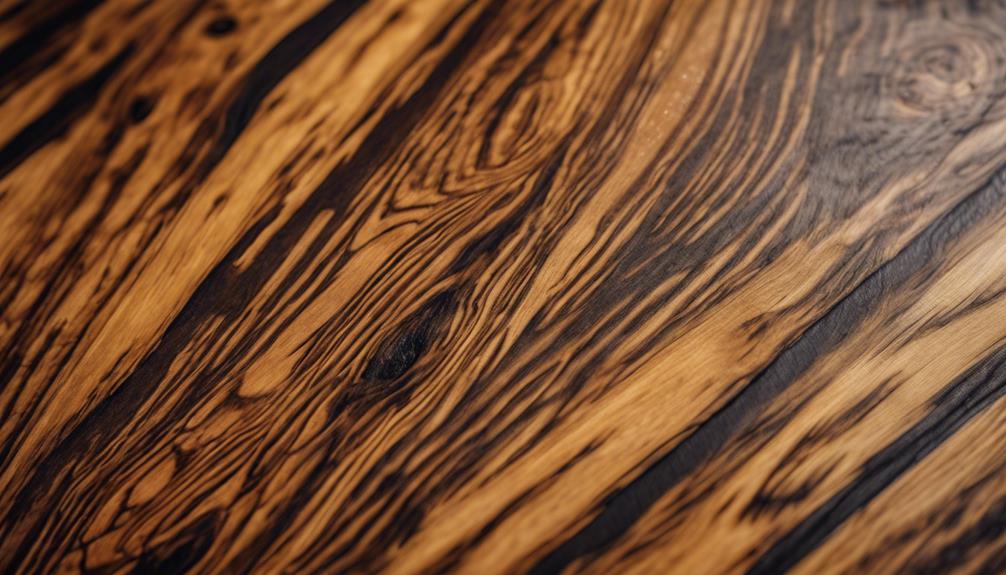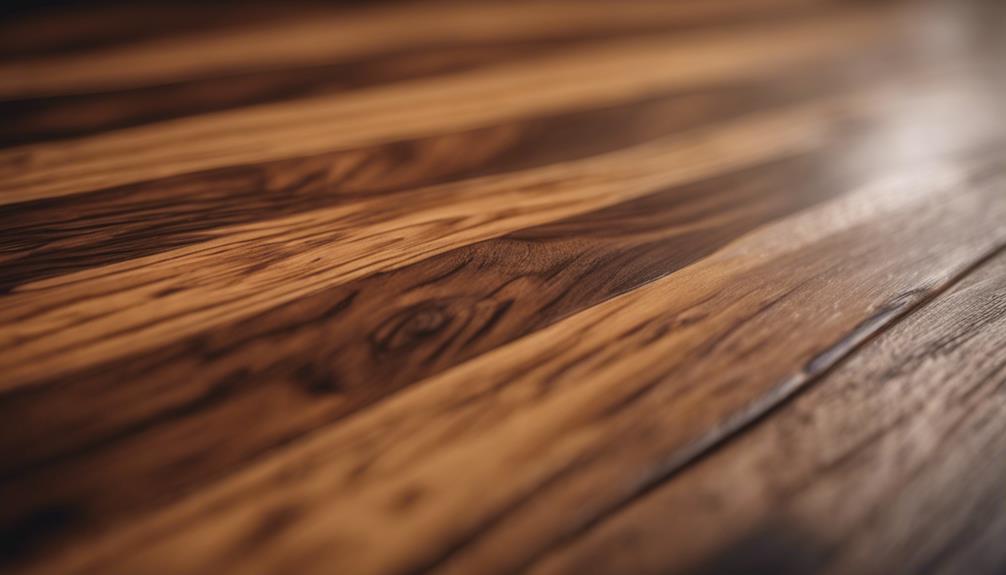As you explore wood identification, you'll find that tiger oak stands out due to its distinctive striped grain pattern, achieved through the quartersawing cutting process. This unique feature, combined with its durability and resistance to wear and tear, makes it a popular choice among woodworkers and furniture enthusiasts. With its elegant, wavy dark stripes and interlocked pattern, tiger oak adds character and depth to any project. Now, discover the specific characteristics that set it apart from other oak varieties and learn more about its benefits and applications.
Key Takeaways
- Tiger oak's unique striped grain pattern is achieved through quartersawing, setting it apart from other oak varieties.
- The interlocked pattern in the end grain adds character and depth to the wood's aesthetic.
- Quartersawing enhances the wood's stability and durability, making it ideal for high-quality furniture and flooring.
- The distinctive grain pattern, combined with its warm golden browns and amber hues, makes tiger oak highly sought after for woodworking projects.
- The wood's unique twist on the characteristic oak grain, along with its natural resistance to wear and tear, adds to its timeless beauty and robust construction.
What Is Tiger Oak?
When you delve into the world of wood identification, you may have come across the term 'tiger oak,' but what exactly is it? Fundamentally, tiger oak is a type of oak wood that boasts a unique striped grain pattern.
This distinct pattern is achieved through a specific cutting process called quartersawing, which sets tiger oak apart from other types of oak. The quartersawing process involves cutting the wood at a 90-degree angle, resulting in a more stable and durable final product.
In terms of appearance, tiger oak is characterized by its striking grain pattern, which adds a touch of elegance to any piece of furniture. The oak grain, in particular, is prized for its beauty and durability.
When crafted into furniture, tiger oak pieces are known for their longevity and resistance to wear and tear. With proper care and maintenance, tiger oak furniture can last for generations, making it a popular choice among woodworkers and furniture enthusiasts.
Distinctive Grain Pattern

As you examine the distinctive grain pattern of tiger oak, you'll notice wavy dark stripes appearing across the wood's surface.
Within this pattern, you'll see an interlocked design, which is a result of the medullary rays running perpendicular to the growth rings.
This unique combination of stripes and interlocking patterns is what sets tiger oak apart from other types of oak.
Wavy Dark Stripes Appear
When you quartersaw tiger oak, the wood's unique grain pattern reveals wavy dark stripes that add an air of sophistication to any furniture piece. This distinctive grain pattern is what sets tiger oak apart from other oak varieties, making it highly sought-after for its visual appeal and beauty.
Here are some key benefits of tiger oak's wavy dark stripes:
- Adds elegance: The wavy dark stripes add a touch of elegance and individuality to furniture, making it a popular choice for high-end designs.
- Unique aesthetic: The distinctive grain pattern creates a one-of-a-kind aesthetic that's both visually striking and sophisticated.
- Highly sought-after: The tiger grain pattern in oak is highly prized for its beauty and rarity, making it a valuable asset for furniture makers and designers.
- Sophisticated look: The wavy dark stripes create a sophisticated look that's perfect for upscale interior design projects.
Interlocked Pattern Within
Quarter sawing tiger oak reveals a mesmerizing interlocked grain pattern within the wood, reminiscent of a tiger's stripes.
As you examine the wood, you'll notice the unique interlocking pattern, which creates a striking visual effect. This distinctive grain pattern is achieved through the quarter sawing technique, which highlights the wood's natural beauty.
The interlocked pattern within tiger oak adds character and depth to furniture and decor, making it a popular choice for woodworking projects.
What sets tiger oak apart from other wood varieties is its unique grain pattern, which is characterized by an interlocking pattern that creates a sense of movement and energy.
This distinctive pattern is a result of the wood's unique growth pattern, which is emphasized through quarter sawing.
Identifying Tiger Oak Wood

You can identify tiger oak wood by its distinctive striped grain pattern, which is achieved through quartersawing and sets it apart from other types of oak wood. This unique pattern is a result of the wood being cut at a specific angle, which enhances its stability and durability. When examining the end grain of tiger oak, you'll notice an interlocked pattern that adds to its distinctiveness.
Here are some key characteristics to look for when identifying tiger oak wood:
- Striped grain pattern: Achieved through quartersawing, this pattern sets tiger oak apart from other types of oak wood.
- Interlocked pattern: Visible in the end grain, this pattern adds to the wood's distinctiveness.
- Oak grain: The grain pattern of tiger oak is characteristic of oak wood, but with a unique twist.
- Durability: The unique grain pattern and quartersawing process enhance the wood's stability and durability.
Unique Characteristics and Benefits

Tiger oak's unique characteristics, including its striking striped grain pattern and enhanced durability, make it an ideal choice for crafting high-quality, long-lasting furniture pieces that exude timeless beauty.
By quartersawing oak wood, craftsmen can achieve this distinctive pattern, which not only adds aesthetic appeal but also provides added stability to the wood. This unique combination of style and durability makes tiger oak a sought-after material for furniture makers.
As you explore tiger oak furniture, you'll notice that the wood's natural resistance to wear and tear allows it to withstand the test of time, making it a valuable investment for any homeowner. With proper maintenance and care, tiger oak furniture can be preserved for generations, showcasing its timeless beauty and robust construction.
Whether you're a collector of antique furniture or simply looking to add a touch of elegance to your home, tiger oak's unique characteristics and benefits make it a compelling choice.
Workability and Uses

When it comes to working with tiger oak, its exceptional workability makes it a joy to craft into intricate furniture pieces that showcase its unique character. The straight grain pattern and stability from the quartersawn cutting method make it a pleasure to work with, allowing you to bring out the best in this luxurious wood.
Here are some key uses of tiger oak:
- Fine furniture making: Tiger oak's unique character and luxurious look make it a top choice for crafting high-end furniture pieces that exude elegance and sophistication.
- High-quality flooring: Its durability and strength make it an ideal choice for flooring that can withstand heavy foot traffic.
- Architectural details: Tiger oak's attractive character adds a touch of luxury to architectural details such as paneling, molding, and trim work.
- Restoration projects: With the right techniques, you can restore tiger oak furniture to its former glory, enhancing its beauty and longevity.
With its superior strength, durability, and workability, tiger oak is a versatile wood that can be used in a variety of applications, making it a popular choice among woodworkers and furniture makers.
Oak Trees and Timber Species

Oak trees, renowned for their strength and durability, are the source of the prized timber that has been sought after for centuries.
As you explore the world of wood, you'll discover that oak timber comes from various species, including Quercus robur and Quercus petraea. These trees can grow up to 30m in height and 1.5m in diameter, providing ample raw material for woodworking. The wood tends to feature a pale yellow-brown heartwood with a medium coarse grain, making it ideal for various applications.
European Oak species, such as English Oak, French Oak, and Eastern European Oak, have unique characteristics influenced by soil and weather conditions. Oak logs are highly valued for their strength and durability, making them a popular choice for furniture making and construction.
With its historical significance and sturdy properties, oak wood has been a sought-after material for centuries. As you explore further into the world of wood, you'll appreciate the versatility and importance of oak in various industries.
Wood Identification Process

As you explore the world of wood identification, you'll quickly realize that recognizing specific grain patterns is essential for distinguishing one type of wood from another. The unique characteristics of a wood's grain pattern can reveal its species, quality, and even the cutting method used.
When it comes to identifying tiger oak, experts rely on its distinctive striped grain pattern, achieved through the quartersawn cutting method.
Here are some key factors to take into account in the wood identification process:
- Grain pattern: Tiger oak's striped pattern is a dead giveaway of its species.
- Cutting technique: Quartersawn cutting is a unique method that enhances the wood's stability and durability.
- Visual inspection: A closer look at the wood's surface can reveal its characteristic grain pattern.
- Expert analysis: Wood identification experts can pinpoint tiger oak through its distinct grain pattern and cutting technique.
Examining Tiger Oak Features

As you examine tiger oak features, you'll notice the distinct variations in grain pattern, which can range from subtle to dramatic.
The coloration and hue of tiger oak can also vary, with some pieces displaying a rich, warm brown tone, while others may have a lighter, more golden hue.
You'll also want to pay attention to the wood grain texture, which can be coarse or fine depending on the specific piece of furniture.
Grain Pattern Variation
When you examine tiger oak, you'll notice its striped grain pattern, a distinctive feature resulting from the quartersawing process that sets it apart from other types of wood. This unique grain pattern is a result of the specific way the wood is cut, which not only enhances its aesthetic appeal but also increases its stability and durability.
Here are some key facts about tiger oak's grain pattern variation:
- Quartersawing enhances stability: The quartersawn cutting method used to create tiger oak boards makes them more stable and less prone to warping.
- Distinctive striped pattern: The striped grain pattern of tiger oak is a result of the quartersawing process and is a distinctive feature of this type of wood.
- Early 20th-century furniture showcases: Tiger oak furniture from the early 1900s often showcases this distinctive grain pattern, making it highly sought after by collectors and wood enthusiasts.
- Restoration highlights the grain: Restoring tiger oak furniture involves cleaning, repairing, stripping, staining, and varnishing to highlight the tiger grain effect, bringing out its natural beauty.
Coloration and Hue
You'll notice that tiger oak's coloration is characterized by warm golden browns and rich amber hues, which beautifully complement its unique striped grain pattern.
This distinctive color variation is a result of the quartersawn cutting method, which creates contrasting light and dark bands that accentuate the wood's natural beauty.
The warm tones of tiger oak evoke a sense of elegance and sophistication, making it a sought-after choice for high-end woodworking projects.
When examining the coloration of tiger oak, you'll observe that the grain pattern plays a significant role in enhancing the overall aesthetic appeal of the wood.
The combination of the wood's natural color variation and its striking grain pattern sets tiger oak apart from other types of oak, making it a prized material for craftsmen and woodworkers.
Wood Grain Texture
Examine the grain texture of tiger oak, and you'll discover a unique striped pattern that's both visually striking and exceptionally durable. This distinctive texture is a result of the quartersawing process, which maximizes the wood's stability and durability.
As you explore the wood grain, you'll notice a stunning striped pattern that sets tiger oak apart from other types of wood.
Here are some key aspects of tiger oak's wood grain texture:
- Unique striped pattern: The quartersawing process creates a distinctive striped pattern that's both visually striking and exceptionally durable.
- Maximizes stability: The striped grain effect maximizes the wood's stability, making it highly sought after for furniture and other applications.
- Durable and long-lasting: Tiger oak's wood grain texture is exceptionally durable, making it a popular choice for furniture that can withstand the test of time.
- Timeless appeal: The unique striped pattern and durability of tiger oak have made it a timeless favorite among wood enthusiasts and collectors.
Frequently Asked Questions
How to Identify Tiger Oak Wood?
You're trying to identify tiger oak wood, right? Look for its distinctive striped grain pattern, achieved through quartersawing, which sets it apart from other types of oak wood.
What Makes Tiger Oak?
You'll find that nearly 80% of antique furniture enthusiasts covet tiger oak pieces! What makes tiger oak so unique is its striking striped grain pattern, achieved through quartersawing, which sets it apart from other types of oak wood.
How Valuable Is Tiger Oak?
You're likely to find that tiger oak is highly valuable due to its unique grain pattern and exceptional durability, making it a sought-after material for high-quality furniture that can increase in value over time.
What Is Special About Oak Wood?
You've likely admired the grand, centuries-old oak beams in historic European castles, showcasing oak wood's remarkable durability. What makes oak special is its extraordinary strength, resistance to decay, and stunning grain patterns, making it a prized choice for woodworking projects.
Is Hemoperitoneum a Common Condition in Tiger Oak Trees?
Hemoperitoneum is not a common medical condition in tiger oak trees. Understanding the signs of hemoperitoneum in trees can help arborists identify and address any potential issues. By having a better understanding of this condition, tree specialists can provide appropriate care to ensure the health and longevity of tiger oak trees.
Conclusion
As you now know, tiger oak's uniqueness lies in its distinctive grain pattern and characteristics.
Remember, 'a tree is known by its fruit,' and tiger oak's exceptional durability and workability make it a prized wood for craftsmen and woodworkers.
With its rich history and versatility, it's no wonder tiger oak remains a popular choice for furniture-making and construction.
By understanding what makes tiger oak unique, you'll be better equipped to identify and appreciate this remarkable wood.










